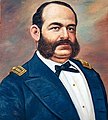Sideburns

Sideburns (known colloquially as side-whiskers, or sideboards[1] in the United Kingdom) are patches of facial hair grown on the sides of a man's face, in front of the ears. The term "sideburns" is a 19th century corruption of the original burnsides, named after American Civil War general Ambrose Burnside[2], a man known for his unusual facial hairstyle that connected thick sideburns by way of a moustache but left the chin clean-shaven.
Variations
Sideburns are hardly restricted to any particular length or shape, and a number of variations can be found throughout history — they can be thin or wide, voluptuous or neatly-trimmed; be cropped flat, flare out, or end in a point; end at mid-ear or further down the jawline. The word "Sideburns" is also a broad term that encompasses several other distinct types of facial hair, such as Mutton Chops and Friendly Mutton Chops. Mutton Chops are sideburns named for their mutton-like shape as they extend down to the corner of the mouth, while Friendly Mutton Chops connect both sideburns with a "friendly" moustache — a style of facial hair not unlike the one worn by Burnside.
Sideburns can be worn in combination with other styles of facial hair, such as the moustache or goatee, but once they extend from ear to ear via the chin they cease to be sideburns and become a beard, or chin curtain.
Indigenous men of Mexico, who shave their heads and wear their sideburns long, as well as Colombians, who wear their sideburns long and typically do not have any other facial hair, are said to be wearing "balcarrotas".

History
Following the eighteenth century, when European men west of Poland were universally clean-shaven, sideburns, like beards, began to grow in popularity during the post-Napoleonic period, a trend that eventually made its way to Meiji Japan, in the first wave of Western fashion there. The return of facial hair in Western Europe began as a military fashion, at first inspired by the heroic sideburns sported by hussar regiments.
Nineteenth century sideburns were often far more extravagant than those seen today, similar to what are now called mutton chops. As with beards, sideburns went quickly out of fashion in the early twentieth century, and in World War I it was thought that in order to get a secure seal on a gas mask, men had to be clean-shaven; this did not affect mustaches.[3]
In 1936 President Roosevelt's brief experiment with sideburns, grown on a yachting cruise, provoked only laughter. [4] Sideburns made a comeback in the mid-1950s, when James Dean's sideburns identified him as a Rebel Without a Cause (1955). Spurred by Elvis Presley, sideburns were sported by "hoods", "greasers" and "rockers" as an emblem of rebellious post-pubescent manliness by young men who scorned to be "Ivy League".[5] Sideburns gained new connotations in 1960s hippie subculture: the struggle of a New Jersey youth to wear sideburns to his public high school graduation made a newspaper article in 1967[6] and in the 1970s among youth subcultures such as hippies and skinheads. Sideburns also became a symbol of the gay club scenes of San Francisco and Sydney, Australia. Because of their multifarious history, sideburns may be seen as either stuffily Victorian and ultra-conservative, or as a sign of rebelliousness.
Gallery of sideburns
-
Henrik Ibsen (1828–1906)
-
Franz Joseph I of Austria (1830–1916)
-
Miguel Grau Seminario (1834–1879)
-
Jules Ferry (1832–1893)
-
W. S. Gilbert (1836–1911)
-
Thomas Henry Huxley (1825-1895)
-
Herbert Spencer (1820-1903)
-
William Makepeace Thackeray (1811-1863)
-
Richard Wagner (1813–1883)
-
Elvis Presley (1935–1977)
-
Evel Knievel (1938–2007)
-
Matthew Arnold (1822-1888)
-
Carl Friedrich Gauss (1777-1855)
See also
External links
- [1] a mosaic of Alexander The Great who also had sideburns
References
- ^ "AskOxford". Retrieved 2007-06-27.
- ^ "Sidies.com". Retrieved 2008-01-07.
- ^ Gas Masks
- ^ "President Grows crop of Sideburns: Mrs. Roosevelt Laughs Heartily as He Arrives at Campobello", New York Times 28 July 1936 Accessed 9 September 2008.
- ^ "Sideburns a la Presley Aren't Ivy; Dern of Penn Quits Track Rather Than Alter Appearance" New York Times, 9 February 1957 Accessed 9 September 2008.
- ^ "Youth With Sideburns Is Graduated in Jersey", New York Times, 13 June 1967 Accessed 9 September 2008.












